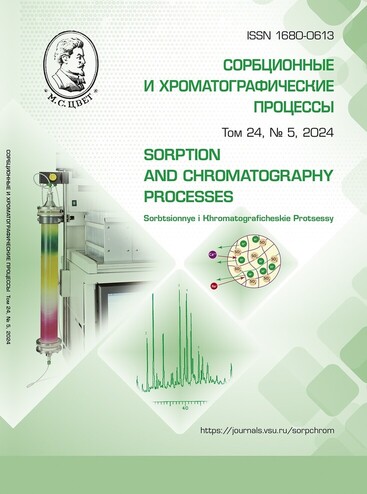Sorption of flavonoids and aromatic acids on hypercrosslinked polystyrene in systems with addition of imidazolium ionic liquids
Abstract
In this work the effect of the addition of five imidazolium ionic liquids (ILs) to the water-acetonitrile eluents on the sorption of aromatic acids and flavonoids on hypercrosslinked polystyrene (HPS) was evaluated by reversed-phase HPLC (RP HPLC). It was found that both the nature of the cation and the nature of the anion of the used IL influence the retention of the studied compounds. The retention of aromatic acids and flavonoids in the systems without and with the addition of trifluoroacetic acid (TFA) to the eluent was investigated. It was shown that the addition of TFA to the water-acetonitrile eluent changes the mechanism of action of imidazolium ILs on the retention of sorbates on HPS. In particular, the sequence of elution of ferulic acid, salicylic acid and caffeic acid in the systems with addition of ILs to the mobile phase on HPS varies depending on the pH of the medium (depend of the addition of TFA). The Snyder-Soczewiński and Soczewiński–Wachtmeister models were used to evaluate the influence of water-acetonitrile eluent composition on the retention of studied compounds. The angular coefficients of the corresponding models were calculated.
Downloads
References
Perez-Vizcaino F., Duarte J. Flavonols and cardiovascular disease, Mol Asp Med. 2010; 31(6): 478-94. https://doi.org/10.1016/j.mam.2010.09.002
Karak P. Biological activities of flavonoids: An overview, Int. J. Pharm. Sci. Res. 2019; 10(4): 1567-1574. https://doi.org/10.13040/IJPSR.0975-8232.10(4).1567-74
Dias M.C., Pinto D.C., Silva A.M. Plant flavonoids: Chemical characteristics and biological activity, Molecules. 2021; 26(17): 5377. https://doi.org/10.3390/molecules26175377
Mizzi L., Chatzitzika C., Gatt R., Valdramidis V. HPLC analysis of phenolic compounds and flavonoids with overlapping peaks, Food Technol. Biotechnol. 2020; 58(1): 12-19. https://doi.org/10.17113/ftb.58.01.20.6395
Bocian S., Buszewski B. Residual silanols at reversed‐phase silica in HPLC–a contribution for a better understanding, J. Sep. Sci. 2012; 35(10-11): 1191-1200. https://doi.org/10.1002/jssc.201200055
Petruczynik A. Effect of ionic liquid additives to mobile phase on separation and system efficiency for HPLC of selected alkaloids on different stationary phases, J. Chromatogr. Sci. 2012; 50(4): 287-293. https://doi.org/10.1093/chromsci/bms004
Hanai T. Fundamental properties of packing materials for liquid chromatography, Separations. 2019; 6(1): 2. https://doi.org/10.3390/separations6010002
Yashin Y.I., Yashin A.Y. Sorbents for HPLC. Current state and new directions of development (Overview), Sorbtsionnye i Khromatograficheskie Protsessy. 2021; 21(2): 235-245. https://doi.org/10.17308/sorpchrom.2021.21/3357
Davankov V., Tsyurupa M. Hypercrosslinked polystyrene as column packing material in HPLC, Compr. Anal. Chem. 2011; 56: 503-521. https://doi.org/10.1016/S0166-526X(11)56013-1
Saifutdinov B.R., Davankov V.A., Il’in M.M., Tsyurupa M.P., Blinnikova Z.K. Selective adsorption of organic compounds from solutions on hyper-cross-linked polystyrenes with ultimate degrees of cross linking, Protection of Metals and Physical Chemistry of Surfaces. 2015; 51: 957-963. https://doi.org/10.1134/S2070205115060209
Saifutdinov B.R., Buryak A.K. Thermodynamic Characteristics and Selectivity of the Liquid-Phase Adsorption of Aromatic Compounds on Hypercrosslinked Polystyrene Networks with Ultimate-High Crosslinking Densities by Data of Liquid Chromatography, International Journal of Molecular Sciences. 2024; 25(3): 1551. https://doi.org/10.3390/ijms25031551
Tsyurupa M.P., Davankov V.A. Porous structure of hypercrosslinked polystyrene: State-of-the-art mini-review, Reactive and Functional Polymers. 2006; 66(7): 768-779. https://doi.org/10.1016/j.reactfunctpolym.2005.11.004
Davankov V., Tsyurupa M., Ilyin M., Pavlova L. Hypercross-linked polystyrene and its potentials for liquid chromatography: a mini-review, J. Chromatogr. A. 2002; 965(1-2): 65-73. https://doi.org/10.1016/S0021-9673(01)01583-7
Deineka V.I., Oleinits E.Y., Blinova I.P., Deineka L.A. Selectivity of the Separation of Isomeric Chlorogenic Acids under the Conditions of Reversed-Phase HPLC, J. Anal. Chem. 2019; 74: 778-783. https://doi.org/10.1134/S1061934819080057
Kartsova L.A., Bessonova E.A., Kolobova E.A. Ionic liquids as modifiers of chromatographic and electrophoretic systems, J. Anal. Chem. 2016; 71: 141-152. https://doi.org/10.1134/S1061934816020064
Carda-Broch S., García-Alvarez-Coque M.C., Ruiz-Angel M.J. Extent of the influence of phosphate buffer and ionic liquids on the reduction of the silanol effect in a C18 stationary phase, J. Chromatogr. A. 2018; 1559: 112-117. https://doi.org/10.1016/j.chroma.2017.05.061
Lei Z., Chen B., Koo Y.M., MacFarlane D.R. Introduction: ionic liquids, Chem. Rev. 2017; 117(10): 6633-6635. https://doi.org/10.1021/acs.chemrev.7b00246
Studzińska S., Buszewski B. Study of retention mechanism of imidazolium‐based ionic liquids in HPLC, J. Sep. Sci. 2010; 33(9): 1264-1273. https://doi.org/10.1002/jssc.200900799
Zhang W., He L., Gu Y., Liu X., Jiang S. Effect of ionic liquids as mobile phase additives on retention of catecholamines in reversed-phase high-performance liquid chromatography, Anal. Lett. 2003; 36: 827-838. https://doi.org/10.1081/AL-120018802
Hu X., Peng J., Huang Y., Yin D., Liu J. Ionic liquids as mobile phase additives for high‐performance liquid chromatography separation of phenoxy acid herbicides and phenols, J. Sep. Sci. 2009; 32(23-24): 4126-4132. https://doi.org/10.1002/jssc.200900538
Guo Y., Yin Z.J., Sun Y. M., Yu H. Separation and indirect ultraviolet detection of common fluorine-containing anions by ionic liquids in reversed-phase chromatography, J. Liq. Chromatogr. Relat. Technologies, 2020; 43(15-16): 597-603. https://doi.org/10.1080/10826076.2020.1769649
Ma Y.J., Guan C., Dong Y.J., Yu H. High-performance liquid chromatography utilization of ionic liquids as mobile phase additives for separation and determination of the isomers of amino benzoic acids, Chin Chem Lett. 2016; 27(5): 749-752. https://doi.org/10.1016/j.cclet.2016.01.023
Wang J., Qiao J.Q., Zheng W.J., Lian H. Z. Effect of ionic liquids as mobile phase additives on retention behaviors of G-quadruplexes in reversed-phase high performance liquid chromatography, J. Chromatogr. A 2024; 1715: 464604. https://doi.org/10.1016/j.chroma.2023.464604
Gao W., Dong X., Wang R., Liu X.G., Li P., Yang H. The use of ionic liquid as a mobile phase modifier in analytical supercritical fluid chromatography for the separation of flavonoids, RSC Adv. 2016; 6(66): 61418-61422. https://doi.org/10.1039/C6RA10975F
Herrera-Herrera A.V., Hernández-Borges J., Rodríguez-Delgado M.Á. Ionic liquids as mobile phase additives for the high-performance liquid chromatographic analysis of fluoroquinolone antibiotics in water samples, Anal. Bioanal. Chem. 2008; 392: 1439-1446. https://doi.org/10.1007/s00216-008-2442-9
Komsta Ł.A new general equation for retention modeling from the organic modifier content of the mobile phase, Acta Chromatographica. 2010; 22(2): 267-279. https://doi.org/10.1556/achrom.22.2010.2.9
Shatc V.D., Sahartova O.V. Vysokoeffektivnaya zhidkostnaya hromatografiya: Osnovy teorii. Metodologiya primeneniya v lekarstvennoj himii [High Performance Liquid Chromatography: Fundamentals of Theory. Methodology of application in medicinal chemistry]. Riga: Zinatne, 1988, 390 p.
Soczewiński E., Wachtmeister C.A. The relation between the composition of certain ternary two-phase solvent systems and RM values, J. Chromatogr. A. 1962; 7: 311-320. https://doi.org/10.1016/S0021-9673(01)86422-0
Pitucha M., Matysiak J., Senczyna B. Synthesis and RP HPLC studies of biologically active semicarbazides and their cyclic analogues 1, 2, 4-triazol-3-ones, Monatsh. Chem. 2012; 143(4): 657-667. https://doi.org/10.1007/s00706-011-0715-z
Deineka V.I., Deineka L.A., Blinova I.P., Kostenko M.O., Oleinitz E.Yu. About chromatographic behavior of flavonoids in reversed-phase HPLC, Sorbtsionnye I Khromatograficheskie Protsessy. 2016; 16(3): 377-383.
Zhao H. Are ionic liquids kosmotropic or chaotropic? An evaluation of available thermodynamic parameters for quantifying the ion kosmotropicity of ionic liquids, Journal of Chemical Technology & Biotechnology: International Research in Process, Environmental & Clean Technology. 2006; 81(6): 877-891. https://doi.org/10.1002/jctb.1449







